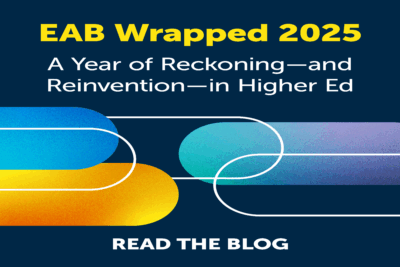Five things university leaders are prioritizing this year (and two they should be)
The results from EAB’s Spring 2023 Pulse Survey are in! We interviewed and surveyed a combined 107 CBOs, Provosts, and Heads of Strategy to understand the challenges dominating cabinet agendas today and get a read on what senior leaders are worried about tomorrow.
While our analysis validated many topics on our research agenda, we also surfaced a handful of surprises. To get started we’ll discuss the top 5 issues our analysis identified as being the most mission or financially consequential this year:
- Tackling the escalating student mental health & wellbeing crisis (58%)
- The effect of demographic decline on enrollment (49%)
- The impact of inflation and higher cost of living on students, faculty, and staff (46%)
- Staff engagement & retention issues (45%)
- Decreasing public confidence in the value of a college degree (43%)
Methodology
EAB launched a pulse survey and interview campaign to Provosts, Heads of Strategy, and Chief Business Officers across North America between March 2023 and April 2023 with the intent of surfacing urgent cabinet challenges and validating our research priorities (n=107).
No.1: Tackling the escalating student mental health & wellbeing crisis
Looking back on the early days of the pandemic it was clear that issues impacting student mental health & well-being would persist beyond mask mandates and social distancing. The early warning signs showed up most prominently in traditionally marginalized groups, with those students experiencing food and housing insecurity at higher rates than their peers – requiring more support to not only persist in their programs but also to live.
Now in 2023, issues with academic readiness and social isolation are having meaningful impacts on retention and student success, including an entirely new phenomenon – “move-in melt.” Several partners have shared anecdotes of students arriving to campus, moving into dorms, and abruptly withdrawing upon re-entering more social settings.
While this new type of melt may not be widespread enough to cause concern, it does speak to the severity of some of the social & emotional challenges faculty, student affairs staff, and behavioral intervention teams have found themselves dealing with over the past academic year.
Successful Mental Health and Well-Being Strategy Requires Cross-Campus Effort
To answer this call for increased mental health support, EAB launched the Mental Health Collaborative in Spring 2022. During this collaborative experience, EAB experts fill skill, knowledge, and capacity gaps to help student success leaders:
- Embed well-being support into more student touch points
- Leverage data to make the case for investing in student mental health & well-being initiatives
- Empower faculty and graduate students to serve as mental health champions
- Partner with Advancement to launch campaigns to fund mental health & well-being needs
Over 50 institutions have now participated in the Mental Health & Well-Being Collaborative, and EAB will welcome the third cohort of this program this Summer.
No. 2: The Effect of Demographic Decline on Enrollment
For years, Nathan Grawe’s predictions of the coming demographic cliff have been part of executive planning discussions – forcing changes in strategy to prepare for an ever-shrinking pool of prospective students. While the demographic cliff is indeed approaching, EAB began to see the edges of a new, unexpected force further pressurizing the system – fewer prospective students opting to enroll in a degree program. We call this non-consumption.
While we are studying the root causes of non-consumption and how executive leadership teams can best prepare for smaller, more skeptical pools of prospective students – I’d encourage administrators to start examining their student value proposition if they have not already. My colleague Madeleine Rhyneer recently fielded a survey with enrollment and admissions leaders, and Differentiating the Student Value Proposition was among the top three priorities cited.
Arguably however, in the context of increasing competition and more skeptical buyers, it is imperative institutions seriously interrogate their student value prop today and bet harder into the experiences they deliver better than anyone else.
EAB research identified strategic thinking and differentiation as key challenges many presidents and leadership teams struggle with, and surprisingly, at the heart of the issue was a general misunderstanding of what “strategy” even is. During my listening tour, one senior finance leader shared that they have invested in several leadership interventions to help former faculty, now administrators build their strategic thinking muscles. After all, strategy as a mode of thinking may not be obvious to some former-faculty-turned-administrators because they are trained to be ultra-specialists in a discipline. Administrators though must develop the broad, business-minded thinking skills associated with strategy to chart a course that will enable success for the institution.
No. 3: The Impact of Inflation and Higher Cost of Living on Students, Faculty, and Staff
Geopolitical tensions, higher borrowing costs, and market volatility have created a toxic environment for everyone’s personal finances – with soaring costs for staples, housing, and energy. Cost-of-living adjustments are not keeping pace in any industry and employees in higher ed are feeling the pinch most with wages already lower than out-of-sector competitors. Increased union activity has corrected this issue for some, but resources are not unlimited and will require leaders to re-examine their budget models and program portfolios. Compounding these resource challenges, the pandemic brought sharply into view the massive campus footprints many institutions sit on, demonstrating possibilities to reclaim and strategically re-deploy one of their biggest assets.
Institutions Are Expending Resources in Ways No Longer Aligned with Needs and Priorities of the Day
Helping senior leadership teams navigate resource constraints and refine their budget models is core to the research and advice EAB has been delivering for the past 15 years. EAB helps leadership teams examine their academic and administrative portfolios for opportunities to efficiently deploy instructional resources and contain costs.
One staple of our research canon many finance leaders have leaned on over the years is our compendium of tactics to improve efficiency and service quality while managing costs.
We also provide more hands-on support through our newly launched Financial Performance Collaborative. Among analyses related to strategic space allocation and program assessment, this virtual series of workshops helps senior leaders find opportunities to improve instructional capacity by consolidating smaller course sections and surfacing courses that may be having a disproportionately negative impact on retention.
No. 4: Staff Engagement and Retention Issues
When I first entered the research and advisory business, the first C-level executive I learned to support was the Chief Human Resources Officer (CHRO). Early on, I had a hard time grasping why HR was so important to overall “organizational effectiveness.” My view had always been that HR was a simple back-office function that provided payroll and benefits administration. From dozens of conversations with cabinet leaders, this thinking is not all that dissimilar to how many have viewed HR at their own institutions.
That said, as my understanding of management and organizational effectiveness grew, it became clear that HR can have a significant impact on organizational performance, employee experience, and growth.
Talent Strategy is Perhaps the Most Important Leadership Imperative for Higher Ed Today
Following that thread, EAB debuted our initial research into the myriad of talent challenges facing higher education leaders at EAB’s IgnitED event in August 2022. At the start of our event series, we shared views into the road ahead and focused on the near-term pain of managing turnover and recruitment. Across the duration of the series, it became clear to most participants that talent was a major strategic risk for their institution, and by the Winter our teaching focused on understanding the longer-range strategic decisions required to continue to attract and retain the best and brightest in higher ed.
As our research teams have continued to refine point of view on modernizing talent management in higher education, decades of underinvestment have come into focus and are clearly on display in essays like the Chronicle’s “Higher Ed Is a Land of Dead-End Jobs.”
EAB’s Fall 2023 research agenda will continue to extend and expand our support for crafting a strategic approach to talent management tailored to the unique organizational structures and realities of higher education. To support some of the immediate talent challenges leaders were facing, EAB introduced the Recruiting and Retention Resource Center this January, including custom audits to help improve Career Websites and Job Descriptions.
One piece of advice I’d share with any higher ed leader is to keep an open mind when it comes to making changes to the way you manage talent. The organizational structures and traditions of shared governance in higher ed make it hard to import some practices from the private sector, however, we can still learn from those approaches. For instance, the concept and idea of the Employee Value Proposition is something almost entirely foreign in higher ed, but it is critical senior leadership teams embrace this idea and understand how it is different from their student value proposition.
No. 5 Decreasing Public Confidence in the Value of a College Degree
An explosion of inexpensive, non-credit training and certification programs has called the ROI of the four-year degree into question, with some employers eliminating degree requirements from their job postings. While this isn’t necessarily new, the uptick in this public skepticism is now paired with worrying patterns of non-consumption, making this phenomenon feel different than it has in the past.
In one set of research shared by Google and IPSOS at the April 2023 ACE Conference, 1 in 4 degree holders who also have completed short courses said their degree qualified them for their job, but short courses better prepared them to do their job.
During our listening tour with senior cabinet leaders this spring, the idea of better communicating the value of a degree featured prominently in several conversations. This challenge is tightly related to institutions honing their student value proposition and focusing on the experiences that make their campus unique. It also signals that institutions need to do a better job helping students tie classroom learning to real-world application.
It’s Past Time to Reclaim the Value of a Degree by Illustrating ROI
This Spring our research agenda is packed with new studies focused on academic innovation and the career outcomes to interrogate what education and career readiness must look like in the future. EAB is also updating our research on Integrating Academic and Career Development to help faculty and provosts help their students better understand and communicate their skills and value to employers.
Gaps of Concern: Where is Diversity, Equity, and Inclusion? And why is AI so Far Down the List?
When I first reviewed the results of our Pulse survey, I was surprised DEI was not even in the Top 10 and further surprised that generative AI and its implications on instruction and administration landed nearly last among 19 issues.
As one of EAB’s DEI experts and researchers, it was concerning to see DEI so far down the list and suggests a deceleration in the urgency and importance of the work to be done.
Our point of view at EAB is that DEI is both mission and margin critical. Right now is not the time to take your foot off the gas. As demographics shift in the US and competition for smaller pools of prospective students intensifies, the impact on margin will only be amplified. Leaders need to be preparing for and investing in institutional initiatives that will promote hiring diverse faculty and staff to support an increasingly diverse student body. Losing focus on DEI today puts future enrollment, persistence, and graduation rates at risk. With EAB’s Institutional Strategy Index for DEIJ, we can help you prioritize your DEI commitments and focus, among a list of initiatives that often feels paralyzingly long.
Generative AI not appearing as a topic of concern for cabinet leaders was also curious. From an innovation standpoint, we’ve heard some administrators compare the hype around AI to the emergence of things like MOOCs that threatened to upend higher ed as we know it.
Comparing AI tools like GPT3 and GPT4 to innovations like MOOCs is misguided at best. Generative AI introduces an entirely new set of capabilities to the market that are not bound by industry and likely will have an impact similar to the introduction of the calculator in the 70s. One Provost we spoke with shared:
“I was in grad school and I remember calculators were a big deal in the intro chem class because of all the premeds and the argument was some students could afford calculators and some couldn’t…now…imagine teaching a class and telling people they weren’t allowed to use calculators. I think that is where we are with AI.”
Our research teams are hard at work studying the landscape of AI and the implications this new capability can have on all aspects of university life. If you are interested in participating in a research interview with our team, please reach out.
Ready to find out more?
To learn more about how EAB’s Strategic Advisory Services can provide you and your teams education, change management, and implementation support on these topics, please reach out via the form belo
More Blogs

What our global partners asked us most in 2025

EAB Wrapped 2025: A year of reckoning—and reinvention—in higher ed
